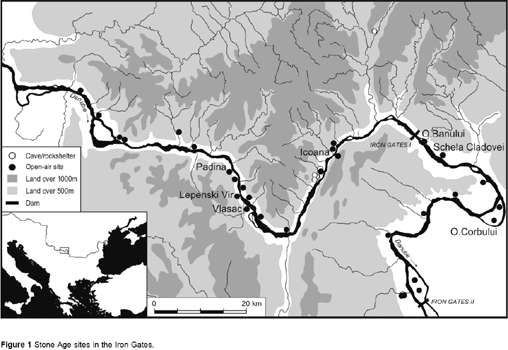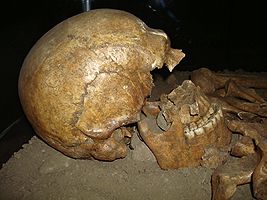
Katherin Ferrier (R) and Jean-Claudi Leblanc (L) work on paleontological layers in the cave Kozarnika © AFP/File Boryana Katsarova
Posted on 08/23/2007 4:41:47 AM PDT by Renfield
Could the Balkans, rather than previously accepted areas such as the Strait of Gibralter, have been the entry point for the first men in Europe?
ORESHETZ, Bulgaria (AFP) - A team of 20 Bulgarian and French archeologists are trying to prove this theory after 11 years of excavation and research in the Kozarnika cave in northwestern Bulgaria.
The digging up at this mountainous site of traces of human activity dating back 1.4 to 1.6 million years throws into question theories about when and where man first set foot in Europe.
According to current theories, the Europeans' prehistoric ancestors came into southern Europe from Africa by crossing the Strait of Gibraltar or the Sicilian channel around 800,000 years ago.
But according to the chief of the French archeological team, Jean-Luc Guadelli of the French National Center for Scientific Research (CNRS), eastern Europe's Bulgaria was also "a perfectly natural route."
Coming from Africa, prehistoric man could reach this part of the continent "very easily along the Mediterranean coast across the Bosphorus and further up along the Danube through the Iron Gates gorges (between Romania and Serbia)," Guadelli told AFP.
Thus prehistoric man, driven by natural curiosity and the search for a milder climate and a better food supply, might have entered Europe through Bulgaria, said Jean-Claude Leblanc of the University of Toulouse.
"We have to change our conceptual schemes," Guadelli said.
Current hypotheses were drawn up "in the 20th century in western Europe based on the rich (archeological) material found there," Bulgarian Academy of Sciences researcher Nikolay Sirakov said.
But the data came from only part of the European land mass and "were considered valid for the whole of it," Sirakov said.
Sirakov, who is co-head of the joint team, and his French colleague Guadelli were in contact for 20 years before finally starting to excavate in the Kozarnika cave in 1996.
The cave, situated in the mountainous region around Belogradchik, is accessible only on foot or by four-by-four vehicle.
It has long been considered by archeologists as a place of human activity from the Old Stone Age, the Paleolithic, and was mentioned in 1920 in the notebooks of the famous Bulgarian archeologist Vasil Popov.
But lack of funding kept excavation workers away.
Notched pieces of bone found in Kozarnika have led archeologists to believe that the cave's first inhabitants had the capacity to formulate abstract thoughts, as they most probably used the regular notches to count things.
The animal bones carrying the series of parallel lines were calculated as dating back to the Old Stone Age. The cuts are too precise to be the result of hacking at the animal to strip away meat, archeologists said.
Researchers are still divided however over whether these prehistoric men could express abstractions.
The Old Stone Age people of Kozarnika did not leave any drawings on the cave walls, which are found in other prehistoric caves around Europe and are considered as a certain expression of symbolic thought.
But the lack of drawings does not question the ability of these people to think in abstract terms, Guadelli said.
Drawings from the Old Stone Age are not found in Bulgaria as a whole and the ancient inhabitants of the area might just have lacked artistic traditions, he said.

Katherin Ferrier (R) and Jean-Claudi Leblanc (L) work on paleontological layers in the cave Kozarnika © AFP/File Boryana Katsarova
Cave Man ping.
" Over the past few years, researchers working at a site called Dmanisi in the Republic of Georgia have unearthed a trove of spectacularly well preserved human fossils, stone tools and animal remains dated to around 1.75 million years ago--nearly half a million years older than the 'Ubeidiya remains."

Ice Age Refuges

Exit From Ice Age Refuges 12,000 Years Ago
Dumb headline.
The answer is undoubtedly both.
First Humans to Leave Africa Weren't Necessarily a Brainy BunchA longstanding view of human evolution holds that the first hominids to leave Africa did so with the help of bigger brains, longer legs and fancier tools than those of their predecessors. That scenario suffered a major blow a couple of years ago, however, when paleontologists working in Dmanisi, Georgia unearthed the oldest human remains yet found outside of Africa -- two 1.7-million-year-old skulls belonging to early members of our genus, Homo -- and discovered primitive tools alongside them. Now a new finding may topple another pillar of the theory. According to a report in the current issue of the journal Science, researchers working at the same site have recovered a third skull -- one that housed a surprisingly small brain.
Kate Wong
Scientific American
July 8, 2002
Exceptionally well-preserved, the fossil, dubbed D2700, exhibits a thin browridge, short nose and large canine teeth, observes team member David Lordkipanidze of the Georgian Academy of Sciences in Tbilisi. With an endocranial volume of roughly 600 cubic centimeters, D2700 was considerably smaller-brained than the other two Dmanisi hominids, whose skulls have some 800 cubic centimeters of brain space. But size differences notwithstanding, the three specimens are, overall, similar in form. The investigators thus believe that the remains represent members of the same species, H. erectus, although they have some features characteristic of the more primitive Homo habilis. It may well be that the D2700 individual was a female and the other two were males, the team posits.
Only time and more fossils will reveal who these intrepid travelers were and why they left their motherland. But as is so often the case in paleoanthropology, the emerging picture appears to be far more complex than previously thought.
Please FREEPMAIL me if you want on or off the
"Gods, Graves, Glyphs" PING list or GGG weekly digest
-- Archaeology/Anthropology/Ancient Cultures/Artifacts/Antiquities, etc.
Gods, Graves, Glyphs (alpha order)
Waiting for the Albanians to clam this discovery as evidence of their ancestry and their claims to all of the Balkans. They are also natives of the greater Detroit and New York metro areas and predate the Native Americans don’t ya know...
Today is no better. Take for example Lepenski Vir civilisation, one of the the most important mesolitic excavations in the world, carefully edited from Art history books.
row, row, row you boat....
My thought exactly. :’)
The Iron Gates has an abundant and continuous record of human occupation in open-air settlements from the Late Mesolithic into the Early Neolithic, c. 8500 - 6500 BP (7500 - 5450 cal BC). While early farming settlements are well represented in other parts of the Balkan peninsula, Mesolithic sites are uncommon and there are few if any sites that were inhabited continuously from one period to the next. Therefore, the Iron Gates is arguably the only area of southeast Europe where the transition from Mesolithic to Neolithic can be studied in detail.



Schela Cladovei. Views of skull.
Display: Iron Gates Museum, Drobeta Turnu Severin Photo: Adrian Gheorghe 2007
BROW RIDGES?
|
|
|||
Gods |
Just updating the GGG info, not sending a general distribution. |
||
|
· Discover · Nat Geographic · Texas AM Anthro News · Yahoo Anthro & Archaeo · Google · · The Archaeology Channel · Excerpt, or Link only? · cgk's list of ping lists · |
|||
Disclaimer: Opinions posted on Free Republic are those of the individual posters and do not necessarily represent the opinion of Free Republic or its management. All materials posted herein are protected by copyright law and the exemption for fair use of copyrighted works.